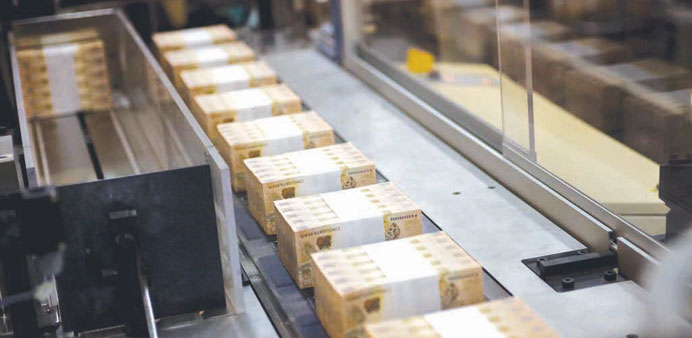Bloomberg /Santiago/Sao Paulo
Foreign investors are betting the worst rout in Latin American currencies since 2008 will extend into next year as commodity export prices slump and rising US bond yields lure money out of the region.
The Bloomberg JPMorgan Latin America Currency Index of the region’s six most-traded currencies fell 9.6% this year and touched 94.6, within 1% of a four-year low. International investors boosted wagers to a record $21.7bn this week that Brazil’s real will keep falling, data compiled by BM&FBovespa SA show. Analysts surveyed by Bloomberg only forecast Mexico’s peso will avoid further losses in the region next year.
All of Latin America’s most-traded currencies fell in 2013 as commodities posted their first annual decline in five years and the Federal Reserve’s push to unwind monetary stimulus sent benchmark 10-year US Treasury yields to a two-year high. Economic growth will slow in Argentina and Chile while the recovery in Brazil falters, according to economists surveyed by Bloomberg.
“There’s a paradigm shift - rising rates and negative export growth at a time when the commodity cycle has ended,” Gustavo Arteta, a currency strategist at UBS AG in Stamford, Connecticut, said in a telephone interview Dec 23. “The region’s countries have been exposed and have to adjust to confront the changes.”
Latin America’s economies are expanding at the slowest pace in four years as a decade-long commodities boom moderates. Commodity prices have fallen 1.1% this year, the first decline since 2008, as an economic slowdown in China cut into demand, according to the Standard & Poor’s GSCI Index. Average growth for countries in the region will be 2.88% in 2014, according to the median forecast of analysts surveyed by Bloomberg. While that’s up from 2.38% in 2013, it’s still less than half the 6.4% rate in 2010.
Signs of improvement in the US economy led the Fed to scale back its purchase of Treasuries that held down yields and helped fuel a credit boom in emerging markets. The Fed’s move will make it harder for Brazil, Chile and Peru to attract capital to finance current-account deficits, according to Arteta. Brazil’s gap in the broadest measure of trade in goods and services widened to 3.7% of gross domestic product in October, the highest since 2002.
“We can sum up this year’s performance in stronger growth in the US and weaker growth in emerging markets,” Eugenio Cortes, the head of currency forwards at EuroAmerica Corredores de Bolsa in Santiago, said in a telephone interview on Dec 23. “The long-term trend is for emerging-market currencies to continue weakening, maybe at a slower rate.”
Brazil’s real has lost 13% this year, extending its decline since the end of 2010 to 30%. The Chilean peso dropped to a two-year low on Dec. 3 and is down 8.4% this year. Mexico’s peso has declined the least, falling 2%, while the Colombian peso and Peruvian sol dropped more than 8%. Argentina’s peso, managed by the central bank through regular foreign-exchange market interventions, tumbled 24%, the most since 2002.
Foreign investors amassed $21.7bn in short real positions as of yesterday, according to information compiled by Bloomberg based on futures contract trading on BM&FBovespa. The short wagers are the highest since Bloomberg began compiling the data in 2005.
In Chile, overseas investors in the peso forwards market raised their net short position by $5.6bn to $11.8bn since the central bank started lowering borrowing costs Oct 17. The wagers reached $12.7bn on Dec. 12, the most in four months, according to data compiled by the central bank.
Central banks in Chile, Colombia, Mexico and Peru cut borrowing costs to counter the economic slowdown, pushing the region’s average benchmark lending rate to 6.82%, the lowest level since at least 2000.
The US recovery, while leading to higher Treasury yields, may help bolster some currencies, including the Mexican peso, by fueling a pickup in demand for exports from developing nations, according to Sebastian Brown, an economist and currency strategist at Barclays Plc.
Mexico, which sends about 80% of its exports to its northern neighbour, is also poised to receive more foreign direct investment after President Enrique Pena Nieto pushed through a constitutional reform this month to open the oil industry to private drilling for the first time in 75 years.
“For the Mexican peso, our scenario is positive partly because of the country’s proximity to the US, and the recovery there will have a positive effect on the currency,” Brown said in a phone interview from New York on Dec 23. “The energy reform will have an important effect in increasing Mexico’s attractiveness for foreign investors, and the currency has some space to strengthen versus the dollar.”
The median forecast of analysts surveyed by Bloomberg is for the peso to rise 3.7% next year. That compares with projected declines of at least 0.1% for the other major Latin American currencies. The real is expected to fall 0.8%, while the Chilean peso will decline 1.7%, the surveys show.
The real has gained 3.7% since Aug 22, when Brazil announced a $60bn intervention that included the auction of $500mn of currency swaps four days a week to bolster the currency and limit import price increases. The central bank said Dec 18 that it will reduce the offerings to $200mn of swaps each trading day from January through at least June.
In Peru, the central bank has sold $5.2bn since July to shore up the sol. Colombia has taken a different tack, trying to weaken the peso and boost foreign reserves by purchasing more than $15bn over the past three years.

Brazil’s real will keep falling, data compiled by BM&FBovespa SA show


